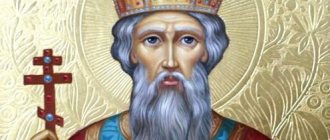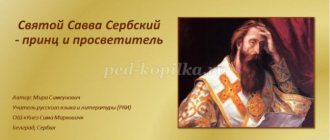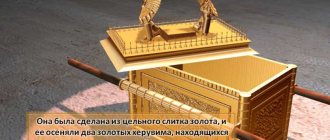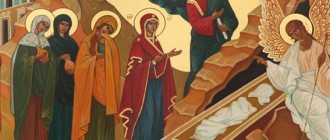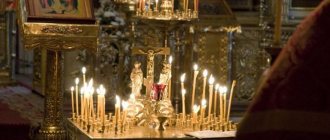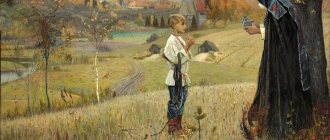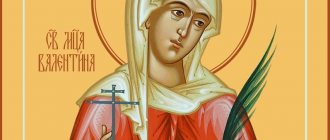| Apostle Bartholomew |
Bartholomew
(Aram. בר תלמי, Greek Βαρθολομαῖος; c.), apostle from 12 June 11 - repose, August 25 - transfer of relics to the island of Lipari and in the Cathedral of the Twelve Apostles
In the New Testament, Bartholomew is mentioned only in four lists of the 12 disciples of Jesus Christ (Mt 10:3; Mk 3:18; Lk 6:14; Acts 1:13). “Bartholomew” is probably a common Aramaic patronymic name (patronymic) - “son of Thalmai” (cf. Joshua 15:14), or “son of Tolomei” [1].
The identification of Bartholomew with the apostle, which has become traditional. Nathanael (John 1:45-51) is argued by the Bollandists [2], referring to the fathers and teachers of the Church, although, for example, Blessed. Augustine opposed their identification [3].
The apostles Bartholomew and Nathanael are identified based on the fact that the name Bartholomew is given in the lists of apostles in the Synoptic Gospels, while the Evangelist John the Theologian classifies Nathanael as an apostle, whom the Synoptic Gospels do not mention. In the Gospel lists of the apostles, where the names are given in pairs, Bartholomew stands next to the apostle. Philip, which allows us to make an assumption about the connection between these apostles (cf. John 1:43-48). In the Evangelist John, it is Philip who informs Nathanael about Jesus; Nathanael's apostolic status is obvious in the story of the miraculous catch of fish on Lake Tiberias, since all the other disciples who witnessed this miracle are apostles (John 21: 1-14). Finally, since Bartholomew is the patronomic name of the apostle, it is conceivable that he could have had another name, Nathanael (Aram. Nathanael
), then the full Aramaic name of Bartholomew is
Nathanael bar Tolami
.
| Ap. Bartholomew. Fresco from the Stavronikita Monastery on Mount Athos. 1546 Icon painters Theophanes of Crete and Simeon |
Byzantine hagiographical tradition or considered ap.
Nathanael as a separate person [4], or identified him with St. Simon the Zealot [5]. Byzantine tradition identifying ap. Nathanael with ap. Simon, is reflected in the liturgical books of the Greek Churches [6]. In the latest works, Greek hagiographers either tend to identify the apostles Bartholomew and Nathanael [7], or give both versions: identifying Nathanael with Bartholomew and with Simon the Zealot [8]. The Russian Church in the 19th century still certainly followed the Greek tradition [9], but already with the publication of “The Lives of the Saints, set out according to the guidance of the Four Menaions of St. Demetrius of Rostov...” [10] their commentator sees in Nathanael the same person as Bartholomew, although he also mentions other opinions (identifying Nathanael with Simon the Zealot or with one of the 70 apostles) [11]. The Holy Scriptures do not say anything definite about the life of the Apostle Bartholomew, unlike Nathanael (see).
According to the apocryphal “Acts of the Apostle Thomas,” Bartholomew was among the 11 apostles who cast lots and each received their own lot for missionary preaching [12]. He preached in Asia Minor (together with the Apostle Philip - in Phrygia and Lycaonia), Mesopotamia, Parthia (Persia) and India (“Martyrdom of the Apostle Bartholomew”), by which some authors meant Ethiopia (Rufinus of Aquileia, Socrates Scholasticus), and others — Arabia Happy [13]. However, in the writings of Eusebius of Caesarea [14] and Bl. Jerome [15] we are talking specifically about India, where Bartholomew left the Gospel of Matthew in Hebrew (or translated into Indian [16]), found by the Christian philosopher Panten, a teacher at the Alexandrian Catechetical School.
In “Acts of St. Andrew" tells about Bartholomew's missionary journey along the Black Sea coast. From “India” he went to Parthia, then to Greater Armenia. On Artashat Hill he met with the Apostle Judas Thaddeus [17].
Bartholomew converted the sister of the Armenian king Vogukha and many nobles to Christianity; By order of King Sanatruk (Astyages), he was crucified upside down, skinned alive and beheaded.
Reverence
| Relics ap. Bartholomew. Italy. Tiber Island. Church of St. Apostle Bartholomew |
There are disagreements regarding the location of the city of Alban (Albanopol, Urbanopol) - the place of death and burial of the Apostle Bartholomew.
Traditionally, this city is identified with the city that existed on the territory of modern Baku. During excavations near the Maiden Tower, Azerbaijani archaeologists discovered the remains of an ancient temple, which was identified with the basilica built on the site of the death of the apostle. In April 2003, Patriarch Bartholomew I of Constantinople visited the site of the alleged burial of the apostle in Baku. According to another version, the Apostle Bartholomew was buried in the province of Western Azerbaijan (now Iran); the monastery of Surb Bartholomew was built on this site in the 14th century. According to M. van Esbrouck, Albanopolis refers to the city of Nikopol (Pontus Province).
Around 410, the relics were transferred from Albana to Bishop. Marufa to Martiropol.
Around 507, by order of the emperor. Anastasia's relics were transferred to the city of Dara (Mesopotamia) Theod. Lect. Eccl. hist. II 57 ]].
In 574, Dara was taken by the Persians, the coffin with the relics of the apostle, according to Gregory of Tours, was thrown into the sea and miraculously, having sailed a huge distance, sailed to the island of Lipari, located between Italy and Sicily [18]. The local bishop Agathon, having received a revelation in a dream, went out with the clergy and all the people to the seashore. Taking the reliquary with the holy relics, they transferred it to their church.
In the middle of the 8th century, part of the relics was transferred from Lipari to Constantinople.
The spread of the veneration of the Apostle Bartholomew in Byzantium is associated with the hagiographic and hymnographic activities of St. Joseph the Songwriter. He received a piece of the relics of the Apostle Bartholomew as a gift from a virtuous man, brought it to his monastery in Thessalonica and built a temple in honor of the Apostle. The Apostle Bartholomew appeared to Joseph in a dream and promised him the gift of singing [19].
Around 838, after the capture of the island of Lipari by the Arabs, the relics of the apostle were transferred to Beneventum, where they are kept to this day.
Since centuries, part of the relics has been in Rome in the Church of St. Bartholomew, on the island of Tiberina. The relics are in the porphyry shrine, located in the main altar [20].
During a visit to Baku, on April 16, 2003, Patriarch Bartholomew I of Constantinople donated part of the relics of the Holy Apostle Bartholomew to Bishop Alexander of Baku and the Caspian Sea as a gift to the Orthodox diocese of Azerbaijan [21].
Apostle Bartholomew is especially revered by the Armenian Apostolic Church, which bases its apostolic succession on the territory of Armenia by the apostle from 12.
The “martyrdom” of Bartholomew [22] is attributed to pseudo-Audias, bishop. Vavilonsky [23]. Also preserved are the “Tale of the Transfer of the Relics of Bartholomew” [24] and “Words of Praise” belonging to St. Theodore Studitus [25], Nikita Paphlagon [26], St. Joseph the Songwriter [27], etc.
On June 11, the Byzantine and Western calendars mark the day of the martyrdom of St. Bartholomew, August 25 (or 24) - transfer of his relics to the island of Lipari. In the Armenian calendars, the memory is indicated on December 8 and February 25, in the Coptic and Ethiopian calendars - on June 18 and November 20.
Are Apostle Bartholomew and Apostle Nathanael the same person?
Nathanael is not mentioned in the Synoptic Gospels or the Acts of the Apostles. But along with Philip, Matthew, Mark and Luke feature the Apostle Bartholomew, whom John does not name. On this matter, in church tradition today there is a consensus that Saint Bartholomew and Nathanael are one and the same person (although, according to some teachers of the Church, both in the Byzantine tradition and in the ancient Russian one they were not identified).
The use of different names should not cause confusion, since such discrepancies occur many times in the Gospels. Experts in ancient languages even reveal the meaning of the name Bartholomew as the son (“bar”) of Falmai (a name found in the Bible). That is, the name Bartholomew is more of a patronymic, a patronymic. But it is under this name that the apostle is further mentioned in various apocrypha and sacred tradition.
Prayers
Troparion app. Bartholomew and Barnabas, tone 3
The tongue was inspired by fire in the power of the Spirit, / you preach the Word that came in the flesh everywhere, / for whose sake the head was truncated, / but he was stoned, / and the natural apostolic face was stolen request,/ Bartholomew and Barnabas,/ we also honor your memory and ask:/ / pray to Christ God to grant us forgiveness of sins.
Troparion app. Bartholomew and Barnabas, Greek, voice 3
[28]
The divine organs of the Paraclete,/ the manifestation of God the Word/ the apostles, the seers of God, appeared,/ Bartholomew, the Twelfth Sepulchre,/ and Barnabo, as the son of consolation./ But pray to Christ God, O all-honoured One,// grant us great mercy.
Kontakion ap. Bartholomew, tone 4
(Similar to: You appeared:)
Thou hast appeared, the great sun of the Church, / teachings with radiance and terrible miracles, enlightening thee singing, // Bartholomew, Lord Apostle
.
Kontakion app. Bartholomew and Barnabas, Greek, tone 4
[28]
As Christ's apostles/ and ministers of piety with dogma,/ you enlighten the whole earth,/ Bartholomew is accepted with Barnabas,// for this reason we sing for you
.
Death of the Apostle Bartholomew
On the way back, the apostle reached the borders of Greater Armenia. There he cast out demons from idols, making them silent forever, and also healed a princess tormented by a demon. Amazed by such miracles, the king and his entire family and court turned to Christ.
But even here the priests began to intrigue against the disciple of Christ; they turned to the king’s brother Astyages. He overtook the apostle in the city of Alban (its location is not exactly known, but many identify it with modern Baku) and ordered Bartholomew to be hanged upside down on the cross.
However, the crucified Bartholomew did not stop his preaching. Then Astyages ordered the skin of the apostle to be removed, but the saint endured this torment without stopping. Finally, by order of Astyages, the executioners cut off the head of Apostle Bartholomew.
Foundation of the chapel at the supposed site of the death of the Apostle Bartholomew
Literature
- Budge EAW The Contendings of the Apostles. L., 1901;
- Schermann T. Prophetarum vitae fabulosae indices apostolorum discipulorumque Domini Dorotheo, Epiphanio, Hippolyto aliisque vindicate. Lpz., 1907. S. 110;
- Quasten. Patrology. Vol. 1. P. 127;
- Brownrigg R. The Twelve Apostles. NY, 1974;
- Leidig E. Natanael, ein Sohn des Tholomäus // Theologische Zeitschrift. 1980. Bd. 36. S. 374-375;
- Esbroeck M., van. The Rise of St. Bartholomew's Cult on Armenia // Medieval Armenian Culture. Chico (Calif.). 1984. P. 161-178;
- Dolbeau F. Une liste latine de disciples et d'apôtres traduite sur la recension grecque du Pseudo-Dorothée // AnBoll. 1990. T. 108. Fasc. 1-2. P. 51-70;
- NTApo. Tüb., 1991-19926. Bd. 1. S. 424-440;
- Bd. 2. S. 404-408.
- “The life and works of the holy, glorious and all-praised twelve apostles of the Lord, the seventy lesser apostles and other equal evangelists of Christ.” 7. St. Apostle Bartholomew. – K.: Printing house of the Kiev-Pechersk Lavra, 2012.
- Saint Demetrius of Rostov. “Lives of the Saints. June". The Life and Sufferings of the Holy Apostle Bartholomew. Memory of June 11. Publication of the Holy Vvedenskaya Optina Hermitage. 1997.
- Basilica di San Bartolomeo Apostolo. Benevento - part 2. Cathedral and Basilica of San Bartolomeo.
Life of the Apostle Bartholomew
The Apostle Bartholomew came from Cana of Galilee, the city where Christ repeatedly visited with His disciples and where He performed several famous miracles: He turned water into wine, healed the son of a courtier. There is no information about the years of his youth. He was then called and followed the Lord, witnessing most of the miracles He performed. And after the Holy Spirit descended on the apostles in the Zion Upper Room, Bartholomew set out, like others, to preach the Gospel to different nations.
There are many apocrypha about this last period of his life, significantly diverging in content, and even directly contradictory to each other. In the form in which the life of the Apostle Bartholomew was preserved in the tradition of the Russian Orthodox Church, it was recorded by St. Demetrius of Rostov.
The Apostle Bartholomew, together with the Apostle Philip, had the lot to preach the faith of Christ north of Palestine: in Syria and Asia Minor. Along with the apostles, Philip’s sister named Mariamne also followed, sharing their preaching labors. Finally, they reached the city of Hierapolis of Phrygia (in the southwest of modern Turkey).
There, through their prayers, the idols that the locals worshiped were overthrown, a blind man regained his sight, and the wife of the city leader was healed. After this, many people believed in Christ and were baptized.
However, the priests of the overthrown idols turned to the city commander with a complaint against the apostles, and he ordered them to be crucified upside down. Suddenly a great earthquake occurred, and the mayor, along with the priests and many unbelievers, was swallowed up by the earth. After this, the survivors and those who were saved finally believed in Christ and hastened to take the apostles down from the cross. But by this time Saint Philip had already given his soul to the Lord.
Torment of the Holy Apostles Philip and Bartholomew
Having buried the martyr and established a Christian church in Hierapolis, Bartholomew and Mariamne went in different directions. And then Apostle Bartholomew followed on his own. First, he went to India and spent a long time there, translating the Gospel of Mark into the local dialect. In addition, he left to the local residents a Gospel written in Hebrew, which a hundred years later was transferred by the Christian philosopher Panten to Alexandria.
see also
- Wikimedia Commons has media related to Bartholomew the Apostle
- St. Bartholomew's Night
- Act of Uniformity - in accordance with it, on St. Bartholomew's Day, August 24, 1662 (“ Black Bartholomew
”), more than 2,000 English nonconformist clergy were expelled from their parishes - The medal in honor of the Holy Apostle Bartholomew is a church award of the Baku and Caspian diocese. Established with the blessing of His Holiness Patriarch Kirill of Moscow and All Rus'.
- San Bartolomeu
New Testament history
Mentioned in the lists of the apostles in the Gospel of Matthew (Matthew 10:3), Mark (Mark 3:18), Luke (Luke 6:14), as well as in the Acts of the Apostles (Acts 1:13). The name “Bartholomew” is possibly an Aramaic patronymic name (patronymic) “bar talamai” - “son of Falmai”[3], where Falmai is the Greek name Ptolemy distorted into Aramaic.
There is an almost unanimous opinion among biblical scholars that Nathanael mentioned in the Gospel of John (John 1:45–50) is the same person as Bartholomew. Consequently, Apostle Bartholomew is one of the first disciples of Christ, called fourth after Andrew, Peter and Philip.
The Evangelist reports that Bartholomew was from Cana of Galilee (John 21:2). Apparently, he was a relative or close friend of the Apostle Philip, since it was Philip who led Bartholomew to Jesus, and in the lists of the apostles they are mentioned side by side. In the scene of the calling of Nathanael-Bartholomew, he utters the famous phrase “ Can anything good come from Nazareth?
"
Jesus, seeing him, says about him, “ This is truly an Israelite, in whom there is no guile
.” The Holy Scriptures do not provide more definite information about Bartholomew; most of his life story is known from apocryphal sources.
Notes
- Saint Bartholomew
- article from Encyclopedia Britannica - Le langage secret de la Renaissance: le symbolisme caché de l'art italien / Richard Stemp. - National geographic France, 2012. - P. 106. - 224 p. — ISBN 9782822900003.
- ↑ 1 2 M. A. Makhanko.
Bartholomew // Orthodox Encyclopedia. - M.: Church and Scientific, 2003. - T. VI: “Bondarenko - Bartholomew of Edessa.” — P. 706—711. — 752 p. — 39,000 copies. — ISBN 5-89572-010-2. - Eusebius of Caesarea. Church history. V, 10
- James R. Russell.
Zoroastrianism in Armenia. - Harvard University Press, 1987. - P. 142. - ↑ 123
Lives of the Saints of Rostov, 1903-1916. - Apostle Bartholomew
- About the Chapel of the Apostle Bartholomew in Baku
- Markova A. A.
Holy Apostles. - M.: Blagovest, 2013. - ISBN 978-5-9968-0285-2. - Basilica di San Bartolomeo Apostolo.
- ↑ 12
The Patriarch of Constantinople handed over to the Orthodox of Azerbaijan part of the relics of St. Apostle Bartholomew - Transfer of the relics of the Apostle Bartholomew
Apocrypha
A number of apocryphal works are associated with the name of Bartholomew:
- "The Gospel of the Apostle Bartholomew" (or "Questions of Bartholomew"). Original in Greek.
- “The Gospel of Bartholomew” (or “The Book of the Resurrection of Jesus Christ by the Apostle Bartholomew”) in Coptic.
- "The Acts of the Apostles Andrew and Bartholomew in the City of the Parthians" in Coptic, Arabic, Ethiopian and Greek.
- "The Acts of Bartholomew the Apostle" in Coptic.
- "The Martyrdom of the Apostle Bartholomew" in Latin and Armenian.
- "Apocalypse of the Apostle Bartholomew" ("Revelations of Bartholomew")
